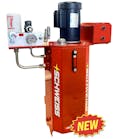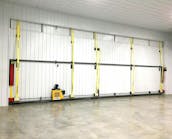During the worst of the COVID-19 pandemic, pictures circulated in newspapers all over the world showing Chinese public health authorities spraying huge volumes of disinfectants into the air. The articles accompanying these photos typically explained the country was doing everything it could to protect human health.
This extreme approach to disinfection was not only happening in Chinese cities, but all over the world, whenever cleaning was performed, in airports, office buildings, and virtually every other facility. For much of 2020, disinfectants were sprayed or applied to just about every nick and cranny imaginable in the cleaning process.
Why was this happening? The initial belief of many global public health authorities was that the virus was spread by touching contaminated surfaces. Disinfecting surfaces was believed to be the surest way to stop the spread and end the pandemic.
What Was Really Happening
Since these pictures were first published, we in the professional cleaning and facility management industries have learned many things about the coronavirus. First and foremost, we now know the virus is most often spread by inhalation, not by touching surfaces. So, much of that disinfecting was for naught.
Further, many of the initial studies indicating that the pathogen that causes COVID-19 can live several days on a surface have been discredited. Those studies were not conducted in "real world" situations, where the pathogen often quickly dries and becomes inactive, according to Emanuel Goldman, a professor of microbiology, biochemistry, and molecular genetics at New Jersey Medical School at Rutgers University. "Those early tests have little resemblance to real-life scenarios."
We have also been reminded, much more than before, that using large amounts of disinfectants can be harmful to the user, typically a cleaning professional, building users, and the environment. Although they have served us well for decades, disinfectants often contain alcohols, chlorine, formaldehyde, glutaraldehyde, quaternary ammonium, and other compounds that have been proven to be health-threatening. These concerns are amplified when disinfectants are used in large quantities or not used properly, which happened during the worst of the pandemic.
And there is something else facility managers and airport administrators should know. Scientific studies going back nearly two decades report that high concentrations of disinfectants can lead to something called antibacterial resistance.2 This means that eventually, some forms of bacteria found on surfaces can become immune—resistant—to the disinfectants traditionally used to eradicate them.
This is very similar to antibiotic resistance. After using the same antibiotics for decades, and in some instances misusing them, many bacteria have become immune to those that have traditionally eliminated different forms of infection. Now to be effective, a cocktail of antibiotics is necessary for certain illnesses and may still prove ineffective.
In the same way, if we misuse or overuse disinfectants, we may need a cocktail of disinfectants to eliminate certain bacteria on surfaces. The problem here is that (1) the chemicals still may not be effective and (2) using a cocktail of powerful disinfectants increases the chances of harming human health and the atmosphere.
To address these issues, we need to step back. Instead of a rush to disinfect, we need to return our focus to effective cleaning by understanding the following:
- What is effective cleaning?
- How can we test for effectiveness?
- What cleaning methods, solutions, tools, and systems are necessary to achieve it?
Understanding Effective Cleaning
Cleaning, as defined by the Centers for Disease Control and Prevention (CDC), is "the removal of foreign material (e.g., unwanted matter, soil, contaminants, and organic material) from objects and surfaces and is normally accomplished using water with detergents or enzymatic products." Enzymatic products are designed to consume soils and contaminants on a surface.
Taking this a step further, effective cleaning requires the use of cleaning solutions, tools, and systems that have proven to eliminate soils from surfaces, and help protect human health, by minimizing or eliminating the transmission of disease. In many cases, effective cleaning is all that may be needed. The CDC even issued a guideline to this effect during the pandemic, and that guideline states:
Normal routine cleaning with soap and water will decrease how much of the virus is on surfaces and objects, reducing the risk of exposure.
Testing for Cleaning Effectiveness
The U.S. Green Building Council's LEED program is currently beta testing a new program that will eventually contribute to LEED certification.
The new program, Safety First: Cleaning and Disinfecting Your Space, is called a "pilot" program, indicating it has not, as of this writing, been made official.
Safety First was created to help address the need for effective cleaning and ensure steps are taken to protect the health of the user and the environment. A vital component of the pilot credit is to scientifically test surfaces to evaluate cleaning effectiveness. This is accomplished with ATP rapid monitoring systems.
Adenosine triphosphate is found in all living cells. If ATP is found on a surface, it can indicate that bacteria, germs, proteins, a virus, or something entirely benign is on that surface. However, when it comes to cleaning and testing for cleaning effectiveness, high amounts of ATP is generally viewed as a red flag that more cleaning – and more effective cleaning – is necessary.
We should note that in a large facility such as an airport terminal or an airport restroom, ATP tests should be conducted on several surfaces, including surfaces directly next to each other, to get a complete picture.
For instance, if an ATP test on Zone 1 proves positive for ATP, but Zone 2 right next to it does not, the assumption airport administrators and cleaning professionals must make is that both Zone 1 and Zone 2 need to be thoroughly, effectively cleaned to protect health.
Cleaning Solutions, Tools and Methods
When it comes to effective cleaning, there are some strict dos and don'ts. First, we don't want to use many traditional cleaning tools. These include mops, buckets, and even traditional cleaning cloths, especially terry cloth wipes. As these tools are used, studies going back to the early 1970s tell us, they become contaminated. Instead of removing soils and contaminants, they begin spreading them to other surfaces.
Instead, we want to use what ISSA, the worldwide cleaning association, refers to as spray-and-vac cleaning systems. These are also known as High Flow Fluid Extraction (HFFE) systems, or most commonly, no-touch cleaning systems.
These systems use one machine to do the following:
- Apply fresh water and cleaning solution, including disinfectants if called for, to all surfaces to be cleaned.
- Allow the cleaning solution to dwell, or set, on those surfaces. Typically, this is accomplished by applying the chemical solution to several surfaces and fixtures throughout the area to be cleaned before rinsing.
- Pressure rinse these same areas. This provides the agitation necessary in all forms of cleaning to loosen and remove soils.
- Vacuum up the moisture, cleaning solution, and with it, soils and contaminants.
This last step is crucial for a busy airport facility because it helps open up a just-cleaned area for use and traffic within minutes.
Another do is to make sure these systems are operated using the correct cleaning solutions, including disinfectants when needed. At least one manufacturer of spray-and-vac systems has introduced an N-List disinfectant. An N-List disinfectant is tested and proven to be effective against the coronavirus.
Moving Forward
Hopefully, we are coming full circle. The pandemic is inching further and further away in many parts of the world and life is returning to normal.
However, we don't want to forget all we have learned. When it comes to disinfecting, we have learned that moderation is key. Only use disinfectants when and where necessary. Realize that in many instances, proven and effective cleaning may be all that is necessary to keep airports safe, healthy, clean - and operating.
Matt Morrison is communications manager for Kaivac, developers of science-based, hygienic cleaning systems that protect the health of building occupants while raising the value of cleaning operations.





